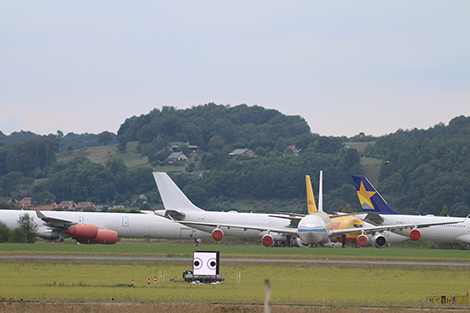Global S&T Development Trend Analysis Platform of Resources and Environment
| Optical illusion spooks raptors | |
| admin | |
| 2018-10-11 | |
| 发布年 | 2018 |
| 语种 | 英语 |
| 国家 | 法国 |
| 领域 | 地球科学 |
| 正文(英文) | Researchers from the CNRS and Université de Rennes 11, in collaboration with Airbus, have designed a visual pattern that elicits long-term avoidance of high-risk areas by raptors. The scientists' work clears the way for further investigation into the visual cognition of these birds, and it has applications for conservation, because raptors are among the most common victims of collisions with planes and wind turbines. Their findings are published in PLOS ONE (October 11, 2018).
Despite their exceptional visual acuity, raptors do not detect some obstacles like glazed surfaces, or they are too late in detecting certain moving objects, like planes. In France, over 800 collisions of birds with planes are reported each year. As available deterrent systems are hardly effective with raptors, scientists from the Éthologie Animale et Humaine (Ethos) research laboratory sought to develop a new means of repelling these birds from specific areas.
Applying current knowledge about vision in these species, the team first observed how captive raptors reacted to a series of visual stimuli. After over 300 tests, they concluded that only one pattern triggered avoidance behavior, by virtue of an optical illusion. This 'superstimulus' consists of concentric black circles on a white background. It creates a so-called 'looming' effect, giving the birds the impression of an imminent collision. The pattern was tested at Lourdes-Tarbes-Pyrénées Airport, near plains where raptors like buzzards and kites forage in the summer. It was displayed continuously throughout the day on two LED screens positioned in strategic locations, while a total of 8,800 observations were made at points all over the airport zone. The team detected a rapid modification of the birds' distribution: they stayed clear of areas from which the screens were visible. This avoidance behavior was still observable after five weeks of continuous pattern display. The fact that the raptor population rose in places where the displays were out of view, at a time when their food supply was nonetheless abundant in all areas, is proof of the pattern's efficacy. Interestingly, the visual stimulus triggered similar behavior among corvids at the site, but not other passerines. These findings are the first to describe a harmless, sustainable solution for repelling raptors from high-risk areas. They also suggest new areas of research, such as the possible role played in this behavior by collision-detecting neurons, specialized in avoidance reactions.  © Anthony Boigné Display showing deterrent pattern at Lourdes-Tarbes-Pyrénées Download the press release :  Notes:1Ethos research laboratory (CNRS / Université de Rennes 1 / University of Caen Normandy) Bibliography:Wide-eyed glare scares raptors: from laboratory to applied management Hausberger M, Boigné A, Lesimple C, Belin L, Henry L. PLOS ONE, 2018. Contacts: CNRS researcher l Martine Hausberger l T (+33) (0)2 23 23 69 28 l martine.hausberger@univ-rennes1.fr |
| URL | 查看原文 |
| 来源平台 | Centre national de la recherche scientifique |
| 文献类型 | 新闻 |
| 条目标识符 | http://119.78.100.173/C666/handle/2XK7JSWQ/106950 |
| 专题 | 地球科学 |
| 推荐引用方式 GB/T 7714 | admin. Optical illusion spooks raptors. 2018. |
| 条目包含的文件 | 条目无相关文件。 | |||||
| 个性服务 |
| 推荐该条目 |
| 保存到收藏夹 |
| 查看访问统计 |
| 导出为Endnote文件 |
| 谷歌学术 |
| 谷歌学术中相似的文章 |
| [admin]的文章 |
| 百度学术 |
| 百度学术中相似的文章 |
| [admin]的文章 |
| 必应学术 |
| 必应学术中相似的文章 |
| [admin]的文章 |
| 相关权益政策 |
| 暂无数据 |
| 收藏/分享 |
除非特别说明,本系统中所有内容都受版权保护,并保留所有权利。
修改评论